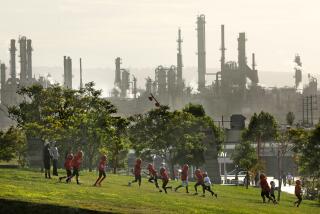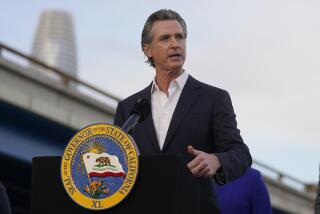Engineering Firms Banking on Country’s Energy Needs
- Share via
There is an urgent need to build power plants, refineries, pipelines and all the other steel-and-mortar facilities of the energy industry in the United States and around the world.
The problems are creating new policy in Washington and new business opportunities everywhere.
California is not alone in lacking power plants, Energy Secretary Spencer Abraham said in a speech last week. “The [U.S.] network of generators, transmission lines and refineries that convert raw resources into usable fuel is woefully antiquated and inadequate to our future needs.”
The problem is worldwide, said Jefferson “Jay” Allen, president of Tosco Corp., a major refining company. “Since the early 1980s, investment has been inadequate in refineries, ships, power generating stations, drilling rigs and other energy infrastructure.”
Poor returns on investment were to blame. Years of relatively low prices for oil, natural gas and electricity turned investors away from energy companies. Wall Street criticized oil and gas firms for spending on exploration for low-priced commodities.
And regulations and restrictions chilled development of facilities. “The last oil refinery built in the U.S. was Benicia, Calif., in 1983 and before that was Corpus Christi, Texas, in 1963,” noted analyst Douglas Terreson of Morgan Stanley Dean Witter.
Facing uncertainties of deregulation, electric utilities didn’t invest in new power plants or transmission lines.
The results of that long period of inaction are today’s shortages of natural gas, relatively high prices for oil and shortages of electricity in California, New York and other states. Attempts to transmit power have been stymied by “a tangle of infrastructure problems and regulatory uncertainty,” said Lawrence Makovich, electric power expert at Cambridge Energy Research Associates.
But now attitudes and economics are changing. The Bush administration is developing an energy policy that will encourage development of oil and gas and the building of power plants, pipelines and transmission lines.
And industry and investors are looking more favorably on building new facilities and refurbishing old ones.
“The economy may be struggling elsewhere, but we’re seeing a lot of strong business in electric power, oil and gas and highway construction,” said Mark Stevens, head of strategic planning for Fluor Corp., an engineering and construction firm that has a record $10-billion backlog of work.
Fluor, based in Aliso Viejo, is one of a handful of engineering firms that builds major projects around the world. Engineering, a global industry, has a heavy California presence.
San Francisco-based Bechtel Group, a privately held company with $15 billion in annual revenue and 30,000 employees, is the world’s largest engineering firm. Another major player, Parsons Corp. of Pasadena, is owned by its 12,000 employees.
Also of Pasadena, Jacobs Engineering has 16,000 employees and $3.4 billion in revenue. URS Corp. of San Francisco ranks among the engineering leaders with 15,900 employees and more than $2 billion in revenue. Keith Cos. of Costa Mesa is a young firm that specializes in building small local power plants.
Foster Wheeler Corp., a Clinton, N.J., firm with $3.9 billion in annual revenue, and Emcor Group of Norwalk, Conn., with $3.5 billion in revenue, round out the engineering leadership.
Wall Street took notice of growing order backlogs and lifted engineering-company stock prices last year, and investors have kept the stocks relatively high through the market’s current downdraft.
That’s important news. Good business for engineering and construction companies is a major indicator for the economy as a whole. Briefly, the signals say that:
* Oil, gas and electricity prices will stay relatively high to support investment in pipelines, power plants, liquefied natural gas plants and other infrastructure. “Companies haven’t yet calculated high energy prices into their budgets. When they do, new building will increase even more,” Terreson predicted.
* Innovations will emerge over the next several years in the energy field. Abraham, for example, said that growing demand for electricity would force the U.S. to build up to 1,900 new power plants in the next 20 years--95 a year. But it’s a good bet that development of smaller, individual power generators for each business and residential community will reduce the number of large plants. Abraham also pledged support for efforts to make coal more environmentally acceptable and to consider development of new kinds of nuclear generators.
* The U.S. and world economies are stronger than current stock market nervousness would have you think. Building of computer and semiconductor plants may be down, but “demand is very strong for specialized pharmaceutical and biotechnology plants,” said John Prosser Jr., Jacobs Engineering’s chief financial officer.
Parsons, which has built many power plants in the southern and eastern U.S., looks forward to building plants in California if the state, as promised, reduces delays in granting permits.
At Foster Wheeler, Chairman Richard Swift noted that his company’s orders for energy facilities rose 24% last year and said that “we are at the start of long-lasting growth for this market.” Foster Wheeler also is a partner with Bechtel and China’s Sinopec to build and maintain a petrochemical complex in South China.
Clearly, a new, expansive era in energy and other industries appears to be at hand. And it’s happening in response to the most basic economic forces of all--growing demand for energy to raise living standards for billions of people around the world. In the Chinese language, the words for crisis and opportunity are closely related.
*
James Flanigan can be reached at [email protected].
(BEGIN TEXT OF INFOBOX / INFOGRAPHIC)
Master Builders
The world’s need for power plants, transmission lines, oil refineries and other energy facilities is creating a lot of work for engineering companies that design and build such infrastructure. Wall Street took notice last year and raised stock prices for these companies. Shown are share prices, latest fiscal year’s sales and earnings per share of publicly traded engineering firms.
*--*
2000 Friday 52-week 52-week sales Company close high low (billions) EPS Emcor $30.46 $31.42 $17.75 $3.5 $2.94 Fluor 41.41 47.50 21.00 9.9 1.56 Foster Wheeler 16.70 17.94 3.94 3.9 0.97 Jacobs Engineering 51.99 58.56 28.75 3.4 2.82 Keith Cos. 22.31 26.44 3.06 .05 0.89 URS 18.56 22.70 10.75 2.2 2.27
*--*
*
Sources: Company reports, Bloomberg News
More to Read
Sign up for Essential California
The most important California stories and recommendations in your inbox every morning.
You may occasionally receive promotional content from the Los Angeles Times.










